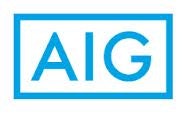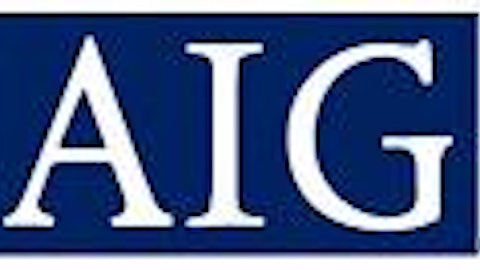US insurance companies, offering not only life- but also property & casualty (P&C) products, have been severely hit by the financial market distress and have been reorganizing their operations to get back on track with healthier balance sheets.

Life insurance business is generally not seen as a growth segment, since it’s a commodity-like business upon which companies have limited ability to achieve competitive advantages. Also, the current global context of record low rates places these companies under enhanced pressure to achieve their required returns. Although some products like variable annuities provide more exposure to equity markets, financial markets distress caused havoc in this segment’s balance sheets. Property & Casualty (P&C) products, on the other hand, are insurance companies’ main drivers of growth, allowing more differentiation and flexibility. This business is also seen as driven by economic growth.
Investing in companies like AIG or Metlife Inc (NYSE:MET), whose efforts in purging their balance sheets and shifting their focus to core businesses appear to be fruitful, would be a wise move if no major restraints are expected from regulators, given that these companies will probably considered too-big-to-fail or SIFIs.
Hartford, on the other hand, increased its leverage and still hasn’t shown a strategic shift in its risky variable annuity businesses. One could wait for its sales channels to be fully settled and generating visible changes in the bottom line and product mix to enter a position in the stock.
American International Group Inc (NYSE:AIG)
finished repaying the US Treasury’s $182.3 billion financial aid in December, 2012. American International Group Inc (NYSE:AIG) was provisionally designated this month as a systemically important company by the Financial Stability Oversight Council, meaning it could pose a risk to the broader financial system if it were to fail. CEO Benmosche’s top priority is debt reduction -leverage is one of American International Group Inc (NYSE:AIG)’s current weaknesses- in order to reinstate dividend payments this year. Although this decision will be subject to FED’s approval once proposed.
One of the company’s strength is its geographical diversification; it recently signed a joint venture agreement with PICC, China’s largest P&C insurer. On the other hand, American International Group Inc (NYSE:AIG)’s management is refocusing on its primary insurance business and is now increasing its focus on P&C and less on life insurance. Having divested many non-core businesses it’s now waiting for regulatory approval to sell 90% of ILFC, its heavily leveraged aircraft leasing company, which accounts for one third of the company’s total debt of $67 billion as of 2012. American International Group Inc (NYSE:AIG) could seize the opportunity should the housing market recover, since its mortgage insurance business would benefit.
One of American International Group Inc (NYSE:AIG)’s main weaknesses is that it repeatedly incurred charges for insufficient reserves. The most recent case was a big charge it took in 2011 for its asbestos claims. Any unforeseen claims increase in this regard poses a threat to the company.
has achieved a strong capital position, with a combined risk-based capital ratio well in excess of regulatory minimums. The rise in equity markets helped improve the company’s portfolios and the continuing reduction in variable annuity business provided some relief in the threatening context of low interest rates.
One of its strengths is its strong brand in a vast geography. Metlife Inc (NYSE:MET) intensified its positioning in emerging markets, which currently generate 14% of earnings, with its acquisition of Alico to AIG in 2010 and its recent buy of AFP Provida, Chile’s largest private pension fund manager. Metlife Inc (NYSE:MET)’s goal is to achieve 20% of its revenue from this countries by 2016.
The company won in February both FED’s and FDIC’s approval to de-register as a bank holding company after selling deposits to General Electric. Analysts consider that this will propel the company to resume share buybacks or raise dividends. Although it would no longer be under the orbit of the FED, it could eventually be named a systemically important financial institution (SIFI), posing a regulatory uncertainty to the company. As a weakness one could point out the concentration of its investment portfolio in corporate debt, MBSs and real estate loans, securities subject to rating changes that could result in write-downs.
has had a leading position in variable annuities, which caused it to be overexposed to equity market downturns and to lose $2.75 billion in 2008. The company took a $3.4 billion of federal bailout money, under the TARP program. Because of pressures of hedge fund manager and shareholder John Paulson, the company sold its individual life business to Prudential Financial and its retirement plans business to Massachusetts Mutual Life Insurance. The company’s strategy is to focus now on its property/casualty, group benefits, and mutual funds businesses.
One of its main strengths is its partnership with AARP (formerly, American Association of Retired Persons), which provides for a customer base. The company has also been expanding its base of producers, and plans to continue doing so. On the other hand, its main weakness is its high level of leverage. In order to repay the Treasury for the TARP investment, Hartford raised equity and more debt. A threat to the company is an unforeseen asbestos claims increase, which are difficult to quantify and predict.
Bottom Line
Investing in companies like AIG or Metlife Inc (NYSE:MET), whose efforts in purging their balance sheets and shifting their focus to core businesses appear to be fruitful, would be a wise move if no major restraints are expected from regulators, given that these companies will probably be considered too-big-to-fail or SIFIs.
Hartford Financial Services Group Inc (NYSE:HIG), on the other hand, increased its leverage and still hasn’t shown a strategic shift in its risky variable annuity businesses. One could wait for its sales channels to be fully settled and generating visible changes in the bottom line and product mix to enter a position in the stock.
Vanina Egea has no position in any stocks mentioned. The Motley Fool recommends American International Group. The Motley Fool owns shares of American International Group and has the following options: Long Jan 2014 $25 Calls on American International Group. Vanina is a member of The Motley Fool Blog Network — entries represent the personal opinion of the blogger and are not formally edited.
The article Insurance Business: Driven by Economic Growth originally appeared on Fool.com is written by Vanina Egea.
Copyright © 1995 – 2013 The Motley Fool, LLC. All rights reserved. The Motley Fool has a disclosure policy.


